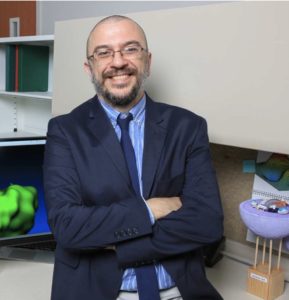In this video, Dr. Jerome Baudry from the University of Alabama in Huntsville describes how he is leveraging computational tools to significantly reduce time to study critical stages of drug design on our path to a cure.
Dr. Baudry, a distinguished researcher in molecular biophysics, is taking a molecular docking approach to predict the binding – or “lock and key” interaction – between the viral protein in the coronavirus and molecules that can counterattack its functions. The molecules that he and his team are using can be found in chemical compounds and other natural elements in plants, fungi, and sometimes animals, to understand how they can be applied to drug development. They’re researching the efficacy of these natural products in attacking the COVID-19 protein to figure out which ones can help to treat or mitigate the effects of the virus. These outcomes are then further tested in pre-clinical and clinical studies.
The team has one mission: to get accurate results and fast. Their plan is to identify which drugs work and which don’t. And to do so in the most efficient way possible, they are modeling and simulating molecular events that take place in each of the various, critical stages in the drug design process. But, that task requires timely access to massive computing power and targeted modeling and simulation capabilities to build complex computational models and deep datasets.
At HPE, we believe in being a force for good, so when the COVID-19 pandemic struck, HPE quickly made available supercomputing resources, along with a dedicated technical staff, free of charge to help scientists tackle complex research. That’s when we met Dr. Baudry and set him and his team up on HPE’s Sentinel supercomputer, which can perform 147 trillion floating point operations per second and store 830 terabytes of data. Sentinel – which is as fast as the earth’s entire population performing 20,000 calculations per second – is significantly accelerating discovery and saving months of research time and hundreds of thousands of dollars.
 HPE’s Sentinel system is a Cray XC50 supercomputer, providing extreme scalability and massive computing power, and uses Intel Xeon Scalable processors. Through a partnership with Microsoft Azure, Dr. Baudry is able to access the supercomputer through the Azure cloud.
HPE’s Sentinel system is a Cray XC50 supercomputer, providing extreme scalability and massive computing power, and uses Intel Xeon Scalable processors. Through a partnership with Microsoft Azure, Dr. Baudry is able to access the supercomputer through the Azure cloud.
Dr. Baudry and team recently kicked off their research journey using HPE’s Sentinel and have already successfully performed 200,000 molecular docking calculations. Now, how did they get this number? The team took a subset of 20,000 molecules of natural compounds from a larger database of 200,000 and calculated how they docked with the virus’ protein to counterattack COVID-19. And they did this with the viral protein that’s positioned in 10 different ways to increase possibilities. These 200K calculations were performed in just 10 hours compared to the few weeks it would typically take on a regular computer cluster. Getting these timely outcomes enables the research team to move projects forward more quickly in the drug design process, and on to experimental drug testing.
Seeing initial progress like this is incredibly inspiring. It’s been remarkable to see the teams at HPE quickly join forces with Dr. Baudry and co-researchers to get projects up and running and make breakthroughs in COVID-19 drug discovery.
Source: Joseph George at HPE
Sign up for our insideHPC Newsletter





